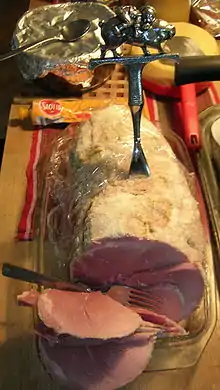Christmas ham
A Christmas ham or Yule ham is a ham often served for Christmas dinner in northern Europe and the Anglosphere.[1] The style of preparation varies widely by place and time.

It is said that the tradition of eating ham evolved from the Germanic pagan ritual of sacrificing a wild boar known as a sonargöltr to the Norse god Freyr during harvest festivals.[2][3][4] The Christian adoption of this tradition stems from St Stephen's Day.
Swedish traditions
The centerpiece of the cold cuts section of a traditional Swedish Christmas smörgåsbord (at Christmas called "julbord") is a large Christmas ham (a cured ham which has been boiled or baked, then coated with a mixture of egg, breadcrumbs and mustard, browned in the oven).[5]
American traditions
In the United States, the way in which the ham is made is variant, and especially often vary by region or by ancestral background. Stuffed ham is popular in southern Maryland, and particularly St. Mary's County, where it is traditional to stuff a corned ham with greens such as kale and cabbage. This tradition has been around in the area for at least 200 years. Similar stuffed hams are also sometimes prepared in Kentucky.[6][7] One tradition from the US South includes preparing a ham with a brown sugar glaze.[8][9] Americans purchase an estimated 318 million pounds of ham around the holiday season, competitive with Christmas turkey.[10][11]
Australian traditions

Ham is a traditional Australian dish that features on most tables on Christmas Day. It is cooked and served in various ways throughout Australia, with many families adding special ingredients, making it an important aspect of a Christmas meal.[12]
As Christmas in Australia comes at the beginning of summer, many people no longer serve a traditional hot roast dinner, serving cold turkey and ham, seafood and salads instead.[13][14] Christmas ham leftovers are often frozen to make soup and other dishes when the summer is over.[15]
Filipino traditions
In the Philippines and among diaspora groups such as Filipino-Americans, a ham is prepared for Christmas celebrations. The ham is referred to as a hamón, from the Spanish word for "ham", jamón. The hamón is sometimes soaked in kumquat and lime juice.[16][17] It is similar to, but not to be confused for, hamonado, which is another Filipino dish that can include pork and is also served around the Christmas season.
References
- Tidholm, P., & Lija, A. (2014). "Culture-Tradition: Christmas: A Family Affair". Sweden.se.CS1 maint: uses authors parameter (link)
- Simek, Rudolf (1998). Die Wikinger. Verlag C.H.BECK oHG. doi:10.17104/9783406616242. ISBN 978-3-406-61624-2.
- Martineau, Chantal (2011-12-22). "In Defense Of Christmas Ham". Food Republic. Retrieved 2020-02-20.
- "The history of the Christmas ham". WFLA. 2016-12-17. Retrieved 2020-12-17.
- Tidholm, P & Lija, A. (2014)
- Severson, Kim (2018-03-19). "In This Corner of Maryland, Holidays Mean a Stuffed Ham". The New York Times. ISSN 0362-4331. Retrieved 2020-12-14.
- Spinner, Jackie (1996-12-11). "TRADITIONS". Washington Post. ISSN 0190-8286. Retrieved 2020-12-16.
- "Southern Holiday Dishes Everyone Should Know How to Make". Southern Living. Retrieved 2020-12-14.
- Menyes, Carolyn (2020-10-06). "Classic Southern Christmas Recipes". Retrieved 2020-12-14.
- "Should You Eat Turkey or Ham This Christmas? An Analysis". Time. Retrieved 2020-12-16.
- Myers, Ginger (2019-10-04). "Why Do We Eat Ham at Christmas?". Evermore Farm. Retrieved 2020-12-16.
- "Australian Average Spend On Groceries at Christmas". Gift of the Month Clubs. Australia. Archived from the original on 2016-03-31. Retrieved 2016-05-17.
- "Christmas Season Celebration in Australia". Australia.gov.au. 2009. Archived from the original on 2016-04-02. Retrieved 2016-05-17.
- "Australian Average Spend On Groceries at Christmas". Gift of the Month Clubs. Australia. Archived from the original on 2016-03-31. Retrieved 2016-05-17.
- "Ham hints". www.foodauthority.nsw.gov.au. Retrieved 2019-03-24.
- "Hamón - Filipino Food". ABOUT FILIPINO FOOD. 2019-12-12. Retrieved 2020-12-14.
- "How Fil-Ams carry on Filipino Christmas traditions —". Asian Journal News. 2017-12-20. Retrieved 2020-12-14.
Bibliography
- Tidholm, P., & Lija, A. (2014). "Culture-Tradition: Christmas: A Family Affair". Sweden.se.CS1 maint: uses authors parameter (link)